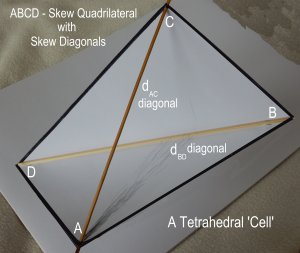Introducing the Tetrahedral Complex
We have a formation of skew lines connecting end-points of corresponding identical intervals on a pair of skew rulers, constructed (in a flagrant breach of projective geometric rules) to allow us to rotate the entire thing “rigidly” around one of these skews by dragging the dashed blue line. ‘Vector’ MP, for example, is represented, most un-projectively, as having constant length. That is, we take that line to be an ‘axis’ – a line bearing the points of incidence of lines with this line, around which those lines can rotate.These transverse lines arise from joining the points of intersection by the original set of skews of regularly-spaced planes, by which we mean planes, all incident in the same line, set at projectively-identical interplanar intervals. For simplicity, we take the “view” to be from infinity through infinitely powerful binoculars. One of the two circles (either at will) must be considered to be in front of the other. If they were not, all the lines would be coplanar, and so not skew. We know thereby that this structure does not lie in or on a surface.
We have a net of skewed quadrilaterals (skewed, because their opposite sides are not coplanar).
It will be appreciated that the two diagonals (here artificially truncated at the vertices for the sake of visual clarity) of each of these quadrilaterals are also not coplanar, and are non-incident, and “pass each other by”, so must be skew to each other.
We thereby have a tetrahedron, formed from the sides of the quadrilateral and its diagonals.
Traced from quadrilateral to quadrilateral, across the corners, the diagonals might appear to form two sets of plane curves, perhaps conics, but, at best, the diagonals are chords of curves, not tangents to them. Conics have deliberately been put through vertices below, whether or not they properly belong there. Clearly, the diagonals are not, and cannot be, tangent to these conics. Also, the conics themselves are mutually skew, so cannot form a surface, appearances notwithstanding.
Bear in mind, too, that because the two diagonals of every quadrilateral in this net are skew to each other, they cannot both be coplanar with the same plane curve, so cannot both be tangent to it. However, they might both be tangent to a “space” curve, such as a vortical path curve — at any rate, one not confined to a plane.
It is a tetrahedral “cell”,
in a net or array
of such cells.
in a net or array
of such cells.
